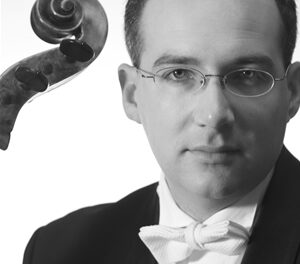The Salisbury Symphony Orchestra, under the baton of Music Director David Hagy, presented the third concert of its season with a program entitled “Romantic Rhapsodies” at Keppel Auditorium on the campus of Catawba College in Salisbury.
In music, a rhapsody is an enthusiastic instrumental composition of irregular form having an improvisatory character. The concert presented five different interpretations of the rhapsody form, all in the “Romantic” musical style, although the close proximity of the concert to Valentine’s Day did not go unnoticed.
The program opener was Hungarian Rhapsody No. 2 by Franz Liszt (1811-86). Liszt is better known to the public for his Hungarian Rhapsodies than for his larger works. He wrote nineteen for piano, and then transcribed six of them for orchestra. The second is one of the most familiar of his concert works. It is based on a type of Hungarian dance known as a czardas, which begins with a slow section and closes with a fast section building up to a frenzy. After a somewhat inauspicious start, the orchestra got it all together to end in a dizzying whirl.
Hugo Alfven (1872-1960) was one of Sweden’s principal composers, in addition to being a great violinist, conductor, painter, and writer. He wrote a great amount of programmatic music, much of it evoking the Swedish landscape. His first Swedish Rhapsody, his best-known piece, captures the festivities associated with Midsummer Night (the summer solstice) celebrations, when the sun does not set. The composer made a detailed program to go with this piece, with a lot of dancing, drinking and merrymaking, which the orchestra imparted to the audience with great fervor.
Georges Enesco (1881-1955), a gifted composer and musician, was extremely absorbed in the folk music of his native Romania. He was struck by the gypsy-style violinists who played in the restaurants and cafes of Bucharest. He sought to capture in his two Romanian Rhapsodies, the first of which was given here, the folk themes they played and to imitate the sounds of some of their ethnic instruments. This was the first piece of classical music I can recall hearing. At the time, it reminded me of the sounds of cars, trucks, buses, and trains of busy city streets, not exactly what Enesco had in mind, but what do you want from a four-year-old? As he was alive at the time, I am sure that he would have understood. Nevertheless, the Salisbury Symphony captured the intended gypsy and folk dance elements with great fervor.
The second half of the program began with Rhapsody on a Theme of Paganini, Op. 43, by Sergei Rachmaninov (1873-1943) for piano and orchestra. The guest soloist was Leslie Ann Davis, a Salisbury native, who holds degrees in piano performance from the North Carolina School of the Arts and Baylor University. She is currently a faculty member of the Snyder Music Academy in Fayetteville, NC.
This Rhapsody is based on the 24th Caprice for solo violin by Niccolo Paganini and is a set of 24 variations grouped into three sections, similar to a conventional concerto. The slow section comprises “love episodes”, and is one of Rachmaninov’s greatest outpourings of sheer lyricism. Davis, in a brilliant red dress (St. Valentine’s day again?), played this beautifully and from the heart. The final section is almost demonic in its brilliance and, again, the soloist played with the frenzy of one possessed.
The concert closed with Maurice Ravel’s (1875-1937) Spanish Rhapsody (Rapsodie Espagnole). Ravel, along with other early 20th century composers, had a fixation on things Spanish. Rapsodie Espagnole is Spain seen through French eyes, and like many Impressionistic paintings, through French gauze. It is in four movements, each capturing some aspect of Spanish tradition: Prelude of the Night, the dances Malagneña and Habanera, and ending with Feast Day. As in the preceding works, this piece builds up to a whirling finale, keeping the orchestra dancing and on its toes.
All of the works presented were very difficult to play, and as one orchestra member said to me, “There were an awful lot of notes!” There were a lot of solo passages, too, for almost all of the principal players – violin, viola, cello, flute, oboe, clarinet, bassoon, harp, percussion – all of whom performed in an exemplary manner, exhibiting great artistry, as did the entire ensemble.
Again, Maestro Hagy and his orchestra are to be congratulated on a fine concert, enjoyed by an unusually large audience.











